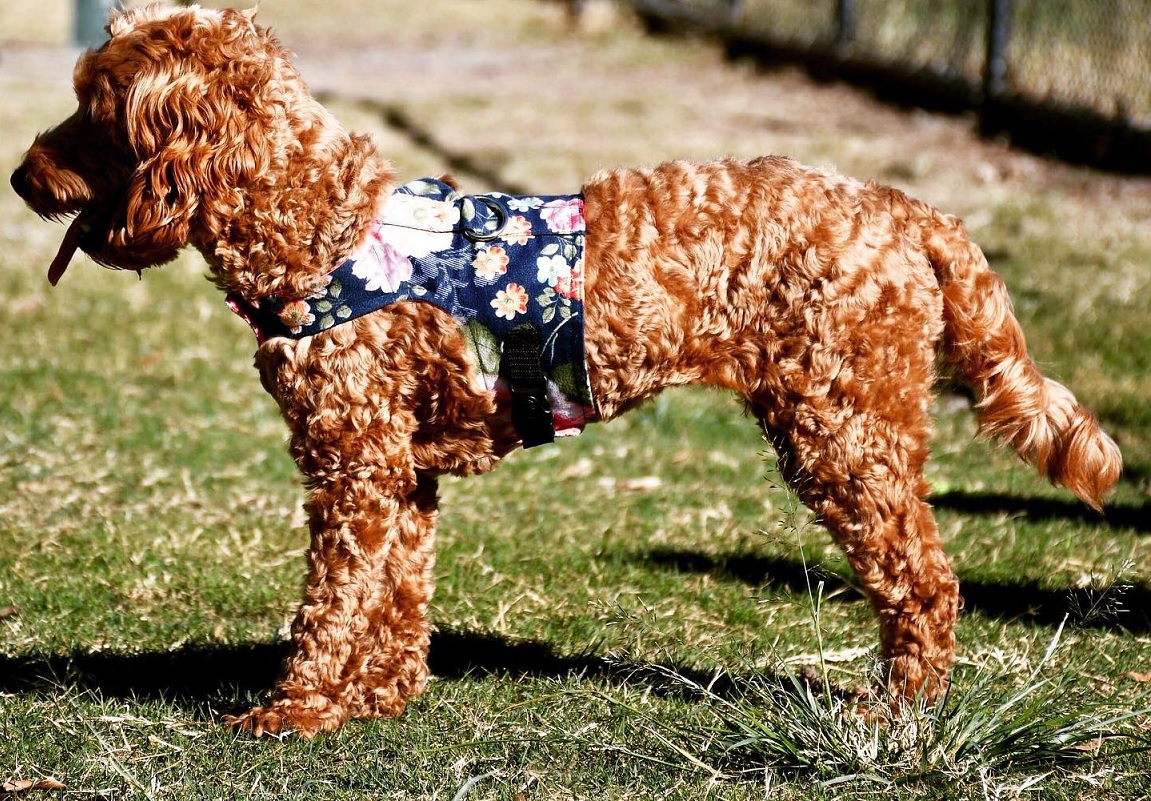Spoodle is a wonderful mixture of two well-tempered breeds, i.e, Cocker Spaniel and Poodle. With a Teddy Bear look and a highly adorable face, it is one of the emerging dog breeds in Australia.
This dog is also known as a Cockapoo, Cockapoodle, or Cockerpoo. So, if you were searching for one of them and ended up here, you are in the right place.
Spoodle is an adorable dog with beautiful, forever puppy eyes and a great sense of humour and fun. The best thing about this beauty is that it knows it’s beautiful, and it would never hesitate to pose for cameras, just like its Poodle parent.
If you’re thinking about bringing a Spoodle puppy into your family and want to learn more about the breed, you’re in the right place. This complete guide covers everything you need to know about Spoodles, from their temperament and health considerations to their pros, cons, and other essential insights to help you make an informed decision.
So, let’s start with the history of Spoodle.
Table of Contents
History of Spoodle
As mentioned earlier, the Spoodle isn’t a purebred dog but a delightful cross between two beloved breeds: the highly intelligent Poodle and the elegant Cocker Spaniel. While the exact origins of the Spoodle remain uncertain, many believe the first intentional crosses took place in the United States around the 1950s. By the 1960s, this charming hybrid gained popularity under the name Cockapoo, winning hearts for its affectionate nature and low-shedding coat.
Spoodle has not been recognised by Dogs Australia, the Australian National Kennel Council, because it is a hybrid dog, and Dogs Australia doesn’t recognise hybrid breeds. Other than Dogs Australia, the American, British, and Canadian kennel clubs have also not recognised this breed yet.
Common Features
Spoodle is one of the cutest and furriest dogs that comes with overloaded intelligence and adorable looks. Some of the common features of a Spoodle are:
- Variety in coats – They may have curly, wavy or straight coats, and the colours vary from white to brindle and cream to black or different patterns.
- Different sizes – From ultra-small to medium, they come in four different sizes known as teacup toy, toy, miniature, and maxi.
- Beautiful eyes and ears – They usually have brown, adorable eyes and cute, floppy ears that make them super-cute dogs.
- Compact bodies – Their sturdy square-shaped bodies are accompanied by deep, wide chests, swishy tails, tiny legs and handsome moustaches on their face.
What’s good about them & what’s bad about them?
Every dog breed has its own mix of strengths and challenges. What may seem like a “negative” trait often comes down to compatibility; how well a dog’s natural temperament and needs match with its owner’s lifestyle, rather than a flaw in the dog’s personality. Likewise, Spoodles also have some positive and negative traits or pros and cons.
Pros of having a Spoodle
Low to non-shedding coats
Spoodles are an excellent choice for those with extreme allergies as they have low to non-shedding coats, thanks to their parent breeds. The Poodle has a curlier coat, which is known for being hypoallergenic, while the Cocker Spaniel sheds moderately throughout the year.
So, expect less dog hair indoors on your sofa, carpet and your clothes. All you need to do is brush your dog once a day to prevent tangling and matting, and you are good to go.
Friendliness
Are you looking for a dog that accepts everyone as a friend? Go get a Spoodle because this adorable pooch is known for its welcoming behaviour towards strangers, kids, elders and even other pets. Beware, they are so sweet-natured that they may end up being friends with even the predators, so they are not suitable as guard dogs.
Excellent companions
As a first-time owner, you won’t find a companion better than a Spoodle. They are intelligent, easy to train and easy to care for. They’ll be ready to accompany you at any time, and they are highly responsive.
Cons of having a Spoodle
Separation Anxiety
Spoodles are prone to separation anxiety and can develop this condition if not socialised at an early age. An introduction to various sounds, scenarios, and different people during their early months would really help them become friendly dogs. Reputable Spoodle breeders start socialising their puppies at an early age, and they usually follow standardised curricula.
They also need to be trained to spend their time in crates and stay alone for certain periods, or they may develop destructive behaviour.
High-Energy Dogs
You need to spend some time daily walking and exercising them. Although they are small in size and adapt well to smaller spaces, too, you need to fulfil their daily activity needs. If you can’t spare up to an hour for your dog, consider getting a low-energy dog.
Temperament and behaviour
When it comes to temperament and behaviour, Spoodles are champions because they love to stay around people. They are easy to train and won’t give you a tough time during the training sessions. Spoodles are so affectionate that they make a strong bond with their owners, and sometimes, they are called Velcro dogs. They are very cuddly, playful, and entertaining.
Spoodles are wonderful posers, and their bright smiles would blow you out. In short, they are a combination of adorable looks, intelligence, and smartness.
Every dog needs to be trained and socialised from an early age, and the same goes for Spoodles. With early socialisation, they’d become obedient and loyal, and you’d barely witness them howling or barking. But one thing is for sure, your pup would be running/playing all day. They are very energetic and love to play ball games.
A Spoodle could be an ideal match for first-time owners who are looking for a cuddly dog that isn’t hard to handle. But note that they could develop separation anxiety and become destructive because they do not like to be separated from their owners, even for a millisecond. This behaviour can be avoided through early training, though. But if your pup develops such a problem, you do not need to leave them alone for a long time. It’s recommended to take the help of an expert behaviourist to tackle this issue.
Living with a Spoodle
Due to its small size, a Spoodle can adapt to all types of houses, whether it’s a small condo or a bigger home with a yard. Although it loves being outdoors during different playing activities, it has the ability to amuse itself indoors.
Spoodles are friendly with their humans, as well as strangers and other pet animals. Instead of chasing your neighbour’s cat, they’d prefer to be friends with them.
If you have small children, try not to leave them unsupervised with these little furry creatures because they could easily be injured due to their small size. Everyone loves a dog that does not excessively bark, howl, or show destructive behaviour, and with early-age training, all of these issues can be prevented.
Care & Grooming
Like all other dog breeds, Spoodle also needs to be taken care of and groomed regularly to stay healthy and happy and maintain its looks.
They have a low-shedding coat that should be brushed regularly to prevent tangling and matting. A visit to a professional groomer for a haircut is also necessary for their handsome appearance.
Being a responsible dog parent, you need to take care of your fur baby regularly. The common routine as a Spoodle parent would be brushing your dog’s teeth to prevent oral health problems. Along with that, you need to bathe them once every 2-3 months or occasionally if you feel their coat is not clean. Also, keep an eye on their ears and make sure there is no wax or foreign objects in them. Don’t forget to clip their nails, or they may injure themselves or anyone around them.
Dietary Needs of a Spoodle
Different breeders may use various food brands for their Spoodle puppies, so it’s always best to check with your breeder or vet before deciding on a diet. Generally, Spoodles do well on high-quality dog food formulated for small breeds. Some owners also include protein-rich options like chicken, turkey, salmon, or grains, but since puppies can have sensitive stomachs, it’s important to introduce new foods gradually.
To avoid health problems, make sure you follow a proper feeding schedule recommended by your veterinarian and monitor your puppy’s weight and energy levels regularly.
Health-related concerns
Spoodles could inherit genetic diseases from one of their parents (Cocker Spaniel and Poodle), especially if the parents are not DNA-tested before they are bred.
In general, they could have slipped stifles, usually known as Luxating Patella or Slipped Kneecap. It may lead to lifelong crippling.
They have floppy ears that can trap moisture and dirt, which can lead to ear infections. To avoid such problems, check their ears regularly and keep them clean.
They may also develop liver-related diseases, so it’s better to take your pup to the vet every six months for regular checkups.
How much does a Spoodle Puppy cost?
You should expect to pay between $2500 and $6000, or maybe more for a Spoodle puppy, depending on various factors such as the colour of the puppy, the breeder’s reputation, location, gender and some other factors.
If someone is offering a puppy for a relatively low price, make sure it’s an ethical breeder and not a puppy farm. Do your homework before choosing a breeder and ask the necessary questions to the breeder to make sure you are not being trapped by an unethical breeder. Getting a puppy from an unethical breeder is not recommended at all, and such puppies are more likely to develop genetic issues.
Puppy Maintenance Cost:
The cost of owning a Spoodle can vary depending on your lifestyle and choices, but as a first-time owner, you can expect to spend around $1,500 in the first year. This includes essentials like dog supplies, puppy food, vaccinations, vet visits, and other care needs. In the following years, expenses may drop to around $1200 annually, though this can change depending on factors such as grooming, health care, and the type of food and accessories you choose for your dog.
Final Words
Every dog makes its owners happy, but a dog like Spoodle that is super-entertaining and loving is just out of this world. So, if you haven’t made a decision on our next puppy yet, now is the best time. Get a Spoodle puppy and thank us later.
Make sure to raise your puppy most lovingly and don’t neglect the fact that your puppy needs to be trained, socialised and raised in a way you raise your human child.
Image credit: Bespoke Spoodles










